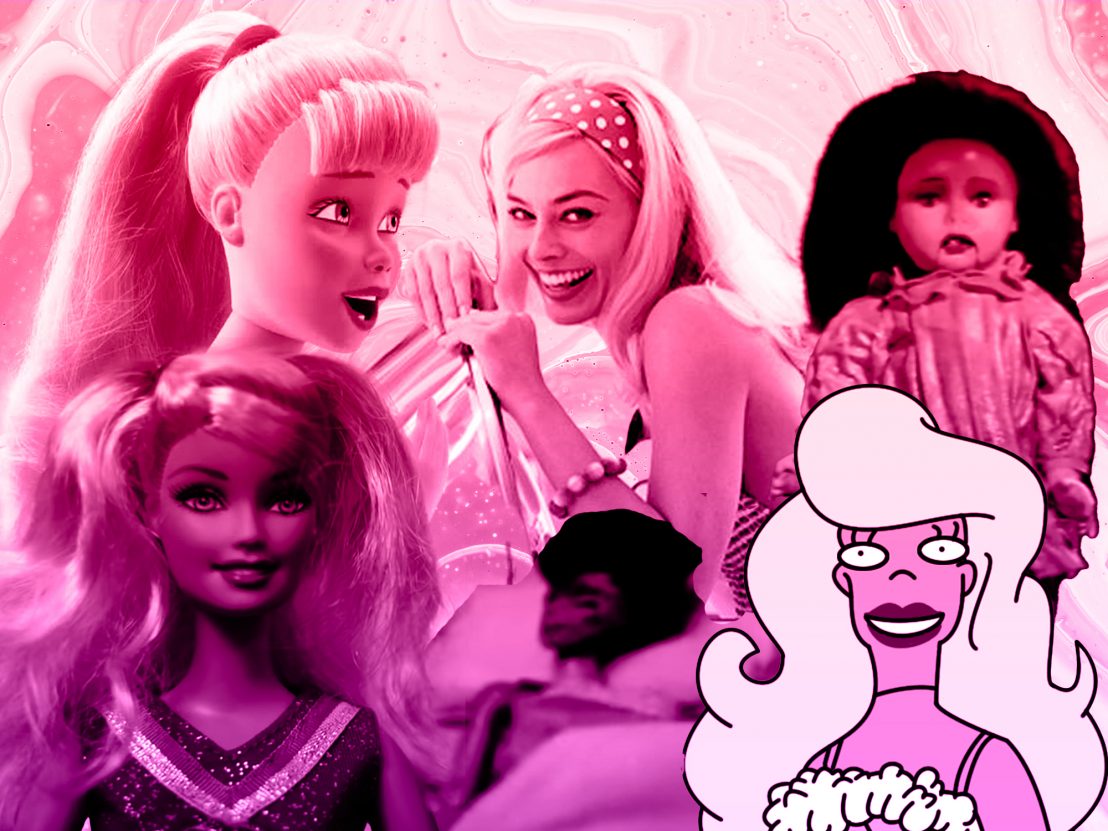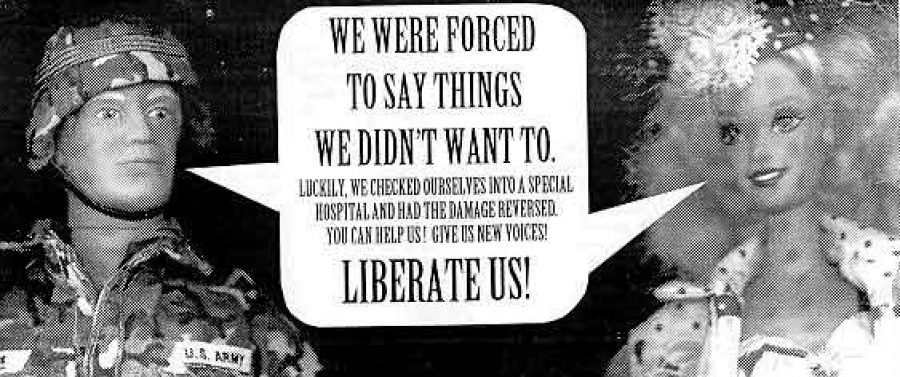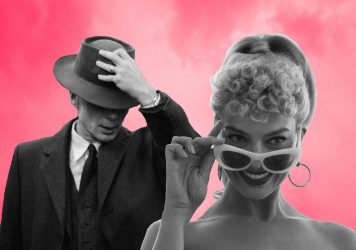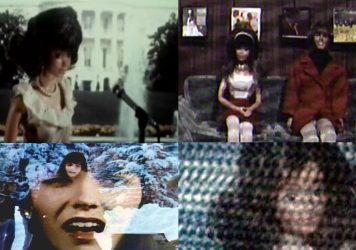
The vast, reflexive irony of the internet has fallen on Greta Gerwig’s Barbie like a hungry zombie on a fresh hunk o’ human. What a camp, metaphysical feast! She appears to be a perfect umami blend of salty piss-take and sweet faithfulness to her iconic lineage – just look at the “Do you guys ever think about dying?” part of the trailer. That drop of existential chaos exquisitely counterbalances the kitsch magnificence of it all. This Barbie has hit every screen ready-memeable, creating the Barbiemania we behold now in our homes and streets, still with a week to go before release.
But ever since her birth, a plastic Aphrodite who arrived fully and perfectly formed, swept by Mattel’s magic to our Earthly shores, Barbie’s image has been continuously parodied, subverted and repurposed – on and off screen. Her 1959 debut advert alone suggests why she’s spawned so much satire. It exhibits her stylish magnetism, but also the bad vibes at Barbie’s core that we’ve begun to yawn at now she’s being fabulously reclaimed. The unreachable ideals she embodies, the consumerism she drives, and her cloying golden-girl perfection cry out to be caricatured.
The Simpsons, ever a zeitgeist-barometer, converts Barbie into ‘Malibu Stacy’ – a constant fixture in the cartoon, but most specifically explored in the 1994 episode Lisa vs. Malibu Stacy. Lisa excitedly unboxes her new talking doll, only to be horrified when she pulls the string and Stacy purrs anti-feminist catchphrases including “Thinking too much gives you wrinkles!” Frustrated that her fellow eight-year-olds don’t share her outrage, Lisa tracks down Stacy Lovell, the doll’s creator, determined to plead her case and make a Malibu Stacy with substance, possessed of “The wisdom of Gertrude Stein and the down-to-earth good looks of Eleanor Roosevelt”. The resulting ‘Lisa Lionheart’ doll almost totally bombs, foiled by the Malibu Stacy executives.
Inspired by public outrage about the Teen Talk Barbie range – rolled out in 1992 uttering pretty sexist phrases – one scene of the episode, in which a doll talks like Spider-Man, makes reference to stunts pulled by the Barbie Liberation Organisation. Drawing attention to gender stereotypes reinforced by these toys, the group swapped the voiceboxes of Barbies and GI Joes, then returned them to the shelves of toy shops across the US. The result was dolls yelling “Vengence is mine!” and action figures squealing “Let’s plan our dream wedding!”.

Such subversive stunts involving Barbies prospered with the birth of YouTube. Mark Cope and Carlo Moss created the hit series The Most Popular Girls in School in 2012, recently described by one wizard in the comments as “What Euphoria wishes it could be”. Self-described as “South Park meets Mean Girls”, MPGiS uses Barbies to convey the obscene soap operatic exploits of the in-crowd at the fictional Oakland High, Kansas.
YouTube has also allowed for the rediscovery of earlier subversive Barbie content – Superstar: The Karen Carpenter Story, in which Barbie plays Carpenter, battling anorexia, spiralling towards her sad demise. Todd Haynes’ 1988 debut feature is made with a full cast of Barbies and miniature sets, spliced with footage of Carpenter herself. Mattel protested Haynes’ use of Barbies unsuccessfully, but the Carpenter family ordered every copy of the film to be destroyed after taking Haynes to Court and winning because he hadn’t obtained music licensing. It can now only be found grainy and bootlegged in dusty corners of the web – being forbidden fruit just adds to its cult appeal.
Full disclosure, I’ve been avoiding this illicit siren call for a while, fearing that it would be – forgive an old anorexic a juicy pun in bad taste – a bit close to the bone. But, though laced with deepest irony, Haynes’ classic treats its subject with sensitivity. The unsettling, darkly amusing use of Barbies means much can go without being said, for the sadness of Barbie is her squeaky-clean lack of agency. That is Karen’s tragedy too; she was adored and manipulated by her family, failed by the callous public eye, and beholden to her internal systems of nutritional dictatorship. Haynes progressively whittles away at the Karen Barbie’s limbs, conveying the grim nuances of the affliction through bizarre body horror, ridding it of A-List glamour.
But before the internet, perhaps Barbie’s most well-known appearance came in Danish-Norwegian Europop band Aqua’s 1997 banger Barbie Girl. Both a loving homage and a satire, its many innuendos jibe at Barbie’s paradoxical smooth sexlessness and hyper-sexualisation. Fittingly, Nicki Minaj and Ice Spice have remixed the old karaoke fave for the Barbie Movie soundtrack. Minaj has long styled herself as a Barbie for our times, challenging the doll’s goody-two-shoes image and overwhelming Whiteness – her most die-hard fans are dubbed the Barbz, and Barbie features heavily in her songs (Barbie Dreams, Black Barbies, Barbie Tingz, Barbie Goin Bad), which, with their snarling ebullience, often toe a thin bubblegum tightrope between tones. Plenty of artists have also embraced Barbiecore, a gleefully post-earnest trend – and not to forget Dolly Parton, who was wittily channelling Barbie way before it was cool.
Lady Gaga, too, has had a crack at skewing Barbie’s chakras. She once bit the head off a Barbie on stage in Tampa, Florida, after reproaching the audience: “…What I don’t appreciate is this horrible excuse for a woman you threw at my stage!” Harsh, but she’s more of a Monster High girlie.
This wild image is the inverse of the cannibal dolls scene from 1968’s sexploitation extravaganza, Barbarella, adapted by Roger Vadim from the comics by Jean-Claude Forest – in which Jane Fonda gets munched by some freaky dolls. Barbarella is designated as a Barbie-burlesque by name and appearance, but there are no overt allusions to the doll. Instead, she can be seen as a mad, grown-up sci-fi version of Barbie, whooshing about the galaxy in her pink spaceship, slipping in and out of bonkers outfits – the Jane Bond of a psychedelic future, humping and dumping a pick n’ mix of Kens. Barbarella endures uncancellable because it’s so camp, silly and fun that to take it seriously in any way is to kill a whole load of joy. It lampoons itself, lavishly, before anyone else can get there and throw stones – as the Barbie Movie seems to be doing.
Barbie gets around – from meta partying in the aisles of Al’s Toy Barn in Toy Story 2 to the 00’s Pygmalion trip of Life Size starring Lindsay Lohan and Tyra Banks, her place in the collective imagination is a moveable feast, always ripe for reinvention. It’s little wonder that Margot Robbie and Greta Gerwig – two artists who delight in subverting our expectations – are next in line to challenge the doll’s on-screen image.
Published 14 Jul 2023

By Joshua Price
Greta Gerwig and Christopher Nolan are two modern auteurs with more in common than an upcoming summer release date...

By Nick Joyner
Over 30 years later, Todd Haynes’ experimental documentary remains a visionary look at female celebrity.

Director Kelly Walker explains how she came up with a novel solution to a creative problem.